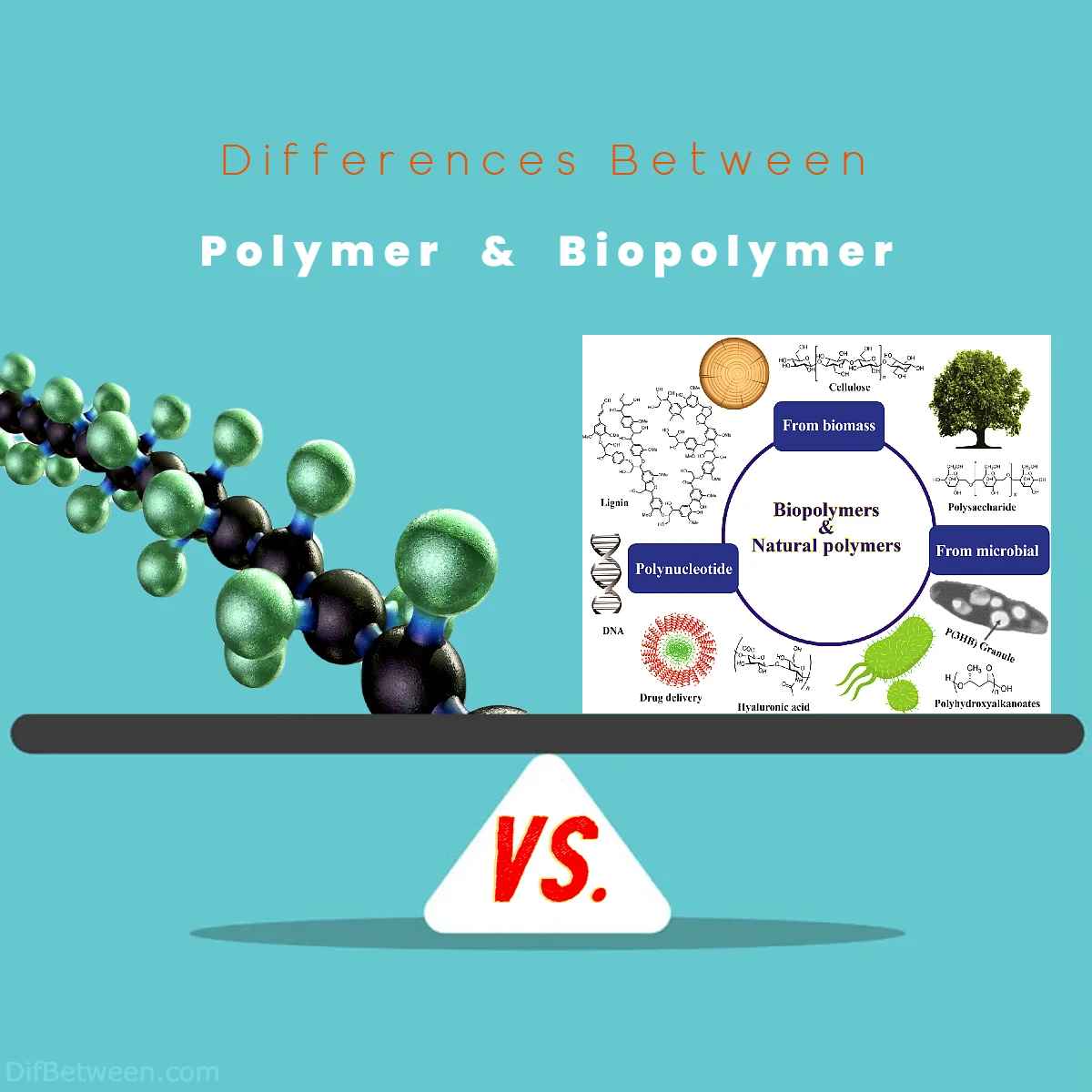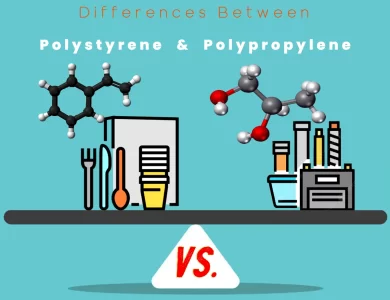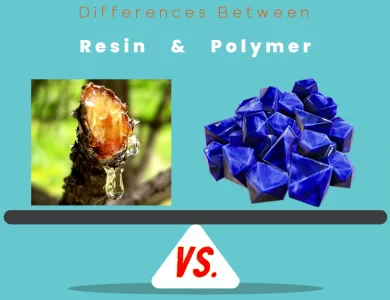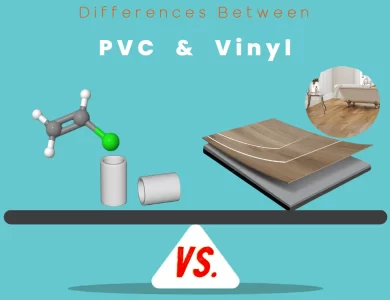
| Aspect | Polymers | Biopolymers |
|---|---|---|
| Composition | Synthetic or semi-synthetic | Naturally occurring |
| Monomers | Derived from various sources | Derived from biological sources |
| Production | Petrochemical processes | Biological processes |
| Origin | Petrochemicals | Living organisms |
| Sustainability | Often non-renewable | Renewable and sustainable |
| Sources | Petrochemicals (crude oil or natural gas) | Renewable biological sources |
| Extraction | Complex chemical processes | Minimal environmental impact |
| Availability | Abundant but non-renewable | Renewable and sustainable sources |
| Properties | Customizable | Inherited from nature |
| Tunability | High | Limited |
| Unique Qualities | Varied, depending on the application | Specific biological roles |
| Environmental Impact | Carbon emissions, non-biodegradable waste | Reduced emissions, biodegradable waste |
| Recycling | Existing recycling infrastructure | Specialized recycling methods |
| Challenges | Contamination, mixed plastics | Easier recycling due to biodegradability |
| Sustainability | Efforts to improve recycling processes | Natural compatibility with recycling processes |
| Cost | Cost-effective, but external environmental costs | Increasing cost competitiveness |
| Feedstocks | Petrochemicals | Renewable biological sources |
| Long-term | Environmental and disposal costs | Potential for reduced environmental costs |
| Regulation | Well-established regulations | Evolving regulatory frameworks |
| Standards | Safety, quality, and performance | Biodegradability and compostability |
| Compliance | Essential for market access | Compliance with evolving guidelines |
| Trends | Diversification, sustainability | Growing applications in eco-friendly sectors |
| Innovation | Sustainable polymer formulations, recycling technologies | Biodegradable and biocompatible formulations |
| Consumer Demand | Sustainability and performance | Eco-friendly and biodegradable materials |
In the dynamic landscape of materials, the distinctions between polymers and biopolymers are as diverse as the materials themselves. From their origins and compositions to their environmental impact and future prospects, we’ll navigate through it all. So, whether you’re pondering the mechanics of a plastic bottle, the biodegradability of a food container, or the potential for sustainable innovations, our journey through the world of polymers and biopolymers promises to be enlightening.
Differences Between Polymer and Biopolymer
The main differences between Polymer and Biopolymer lie in their composition and sources. Polymers are typically synthetic or semi-synthetic, derived from petrochemicals through complex chemical processes, while Biopolymers are naturally occurring and originate from biological sources within living organisms. This distinction extends to their environmental impact, with Polymers often posing concerns due to non-biodegradability and dependence on non-renewable resources, whereas Biopolymers are considered more eco-friendly, being biodegradable and sourced from renewable biological materials. These disparities make it crucial to understand and choose between these materials wisely, considering both performance and sustainability.
1. Composition
Polymers: The Synthetic Marvels
Polymers, derived from the Greek words “poly” (meaning many) and “meros” (meaning part), live up to their name. They are composed of repeating units known as monomers, linked together through chemical bonds. These monomers can be of synthetic or semi-synthetic origin, resulting in a vast array of polymers with diverse properties.
The most common synthetic polymers include polyethylene, polypropylene, polyvinyl chloride (PVC), and polyethylene terephthalate (PET). These materials are typically derived from petrochemicals through polymerization processes.
In synthetic polymers, the monomers are often produced through chemical reactions that involve the manipulation of hydrocarbons, resulting in a wide range of properties, from the flexibility of rubber to the rigidity of plastic.
Biopolymers: Nature’s Own Creations
On the other hand, biopolymers are naturally occurring polymers found in living organisms. They are primarily composed of monomers derived from biological sources. The most famous example of a biopolymer is DNA, which consists of nucleotide monomers. Another well-known biopolymer is cellulose, a major component of plant cell walls, composed of glucose monomers.
The intriguing aspect of biopolymers is their renewable and sustainable origin. They are created through biological processes within organisms, making them inherently eco-friendly. These biopolymers often play vital roles in the structure and function of living organisms, such as providing structural support, storing genetic information, and facilitating biochemical reactions.
Comparison:
Let’s summarize the composition differences between polymers and biopolymers in a table for quick reference:
| Aspect | Polymers | Biopolymers |
|---|---|---|
| Composition | Synthetic or semi-synthetic | Naturally occurring |
| Monomers | Derived from various sources | Derived from biological sources |
| Production | Petrochemical processes | Biological processes |
| Origin | Petrochemicals | Living organisms |
| Sustainability | Often non-renewable | Renewable and sustainable |
2. Sources
Polymers: Petrochemical Origins
Synthetic polymers are predominantly sourced from petrochemicals. These petrochemicals, such as ethylene and propylene, are derived from crude oil or natural gas. The production of synthetic polymers involves complex chemical processes, including polymerization, to transform these raw materials into the desired polymer products.
One of the advantages of using petrochemicals as the source for synthetic polymers is their availability in large quantities. However, the extraction and processing of petrochemicals have well-documented environmental concerns, including carbon emissions and habitat disruption.
Biopolymers: A Gift from Nature
Biopolymers, as the name suggests, originate from nature. They are found in living organisms, including plants, animals, and microorganisms. These polymers are typically extracted or synthesized from renewable biological sources.
For instance, starch, a biopolymer, is derived from crops like corn or potatoes. Chitin, another biopolymer, can be sourced from the shells of crustaceans. The production of biopolymers often involves minimal environmental impact, as it relies on renewable resources.
Comparison:
To better understand the sources of these polymers, let’s create a table summarizing the differences:
| Aspect | Polymers | Biopolymers |
|---|---|---|
| Sources | Petrochemicals (crude oil or natural gas) | Renewable biological sources |
| Extraction | Complex chemical processes | Minimal environmental impact |
| Availability | Abundant but non-renewable | Renewable and sustainable sources |
3. Properties
Polymers: Tailored for Specific Needs
Synthetic polymers are renowned for their versatility, and their properties can be fine-tuned to meet specific requirements. This tunability arises from the ability to control the type of monomers, polymerization methods, and additives used during production.
Properties such as tensile strength, melting point, flexibility, and transparency can be customized to suit diverse applications. For example, low-density polyethylene (LDPE) is flexible and used in plastic bags, while high-density polyethylene (HDPE) is rigid and employed in bottles.
The vast range of synthetic polymers means that they can be designed for various purposes, from the insulation of electrical cables with polyvinyl chloride (PVC) to the biocompatible materials used in medical implants.
Biopolymers: Nature’s Blueprint
Biopolymers, in contrast, inherit their properties from nature’s design. While their properties may not be as easily customizable as synthetic polymers, they often possess unique qualities that make them invaluable for specific applications.
For instance, cellulose, a biopolymer found in plant cell walls, is known for its exceptional strength and is used to make textiles, paper, and even some biodegradable plastics. DNA, another biopolymer, serves as the blueprint for all living organisms and is unrivaled in its ability to store and transmit genetic information.
The properties of biopolymers are inherently linked to their biological functions, making them ideal for specific roles in living organisms.
Comparison:
Let’s summarize the property differences between polymers and biopolymers in a table:
| Aspect | Polymers | Biopolymers |
|---|---|---|
| Properties | Customizable | Inherited from nature |
| Tunability | High | Limited |
| Unique Qualities | Varied, depending on the application | Specific biological roles |
4. Environmental Impact
Polymers: Ecological Concerns
The production and disposal of synthetic polymers have raised significant environmental concerns. The reliance on petrochemicals as raw materials contributes to carbon emissions and dependence on fossil fuels. Additionally, the persistence of synthetic polymers in the environment, especially non-biodegradable ones like polyethylene, has led to pollution issues.
Efforts to mitigate the environmental impact of synthetic polymers include recycling programs and the development of biodegradable alternatives. However, addressing these concerns remains a complex challenge.
Biopolymers: A Green Choice
Biopolymers, on the other hand, are often considered a more environmentally friendly option. Their renewable sources and biodegradability make them a greener choice for various applications. When biopolymers reach the end of their lifecycle, they can naturally break down into harmless compounds, reducing pollution and waste.
For example, biodegradable plastics made from biopolymers like polylactic acid (PLA) are gaining popularity as an eco-friendly alternative to conventional plastics. These materials decompose more readily in composting facilities, reducing their environmental impact.
Comparison:
Let’s create a table to summarize the environmental impact of polymers and biopolymers:
| Aspect | Polymers | Biopolymers |
|---|---|---|
| Environmental Impact | Carbon emissions, non-biodegradable waste | Reduced emissions, biodegradable waste |
| Sustainability | Often non-renewable | Renewable and sustainable sources |
| Eco-friendliness | Environmental concerns and challenges | Generally considered eco-friendly |
5. Applications
Polymers: Ubiquitous and Diverse
Synthetic polymers have permeated nearly every aspect of modern life. Their versatility and customizable properties make them suitable for a wide range of applications, including:
- Packaging: Plastic films, bottles, and containers.
- Construction: PVC pipes, insulation materials.
- Automotive: Tires, interior components, bumpers.
- Electronics: Insulation for wires and cables.
- Medical: Implants, prosthetics, drug delivery systems.
- Textiles: Clothing, upholstery.
- Aerospace: Lightweight materials for aircraft.
Their prevalence in daily life underscores their importance in various industries.
Biopolymers: Niche and Growing
Biopolymers, while not as ubiquitous as synthetic polymers, are gaining traction in specific applications due to their sustainable and biodegradable nature. Some notable uses include:
- Biodegradable Plastics: Polylactic acid (PLA) for packaging.
- Pharmaceuticals: Biodegradable drug delivery systems.
- Agriculture: Biodegradable mulch films and seed coatings.
- Tissue Engineering: Scaffolds for regenerative medicine.
- Food Packaging: Edible films and coatings.
The growth of biopolymer applications is driven by the increasing emphasis on sustainability and environmental responsibility.
Comparison:
To summarize the applications of polymers and biopolymers, let’s create a table:
| Aspect | Polymers | Biopolymers |
|---|---|---|
| Applications | Widespread in various fields | Growing niche in sustainable applications |
| Versatility | Versatile and diverse | Specific applications |
| Sustainability | Less environmentally friendly | Considered environmentally friendly |
6. Future Prospects
Polymers: Advances in Sustainability
The future of synthetic polymers lies in making them more sustainable. Researchers are exploring alternative sources for monomers, such as plant-based feedstocks, to reduce dependence on petrochemicals. Additionally, recycling technologies are advancing to minimize the environmental impact of synthetic polymers.
Nanotechnology is another frontier, offering the potential to enhance the properties of synthetic polymers further. For instance, nanocomposites could make polymers stronger, more durable, and even self-healing.
Biopolymers: Expanding Horizons
Biopolymers are poised for growth as society becomes more eco-conscious. The development of new bioplastic formulations, coupled with improved processing techniques, will expand their range of applications.
Biopolymer-based materials may play a pivotal role in addressing critical environmental challenges, such as reducing plastic waste in oceans and landfills. Additionally, biopolymers are likely to find increased use in the medical field, particularly in tissue engineering and drug delivery.
7. Biodegradability
Polymers: Persistence in the Environment
One of the significant challenges associated with synthetic polymers is their resistance to degradation. Many synthetic polymers are non-biodegradable, meaning they persist in the environment for extended periods. This persistence has led to concerns about plastic pollution, with plastics accumulating in oceans, landfills, and ecosystems.
While efforts are underway to improve the recyclability of synthetic polymers and reduce their environmental impact, the biodegradability of most traditional plastics remains limited.
Biopolymers: Natural Biodegradability
Biopolymers, by contrast, are often inherently biodegradable. This means they can be broken down by microorganisms into simpler, environmentally benign compounds over time. Biodegradability is a crucial advantage of biopolymers, especially in applications where disposability and reduced environmental impact are essential.
For example, biodegradable packaging made from biopolymers can decompose in composting facilities, reducing the burden on landfills and the environment. Biodegradable bioplastics like PLA can replace traditional plastics in single-use items, offering a more sustainable alternative.
Comparison:
Let’s summarize the differences in biodegradability between polymers and biopolymers:
| Aspect | Polymers | Biopolymers |
|---|---|---|
| Biodegradability | Often non-biodegradable, persistent in the environment | Often biodegradable, environmentally friendly |
| Environmental Impact | Concerns about plastic pollution | Reduced environmental impact through biodegradation |
8. Recycling
Polymers: Challenges in Recycling
Recycling is a critical aspect of reducing the environmental impact of polymers, particularly synthetic ones. While recycling programs exist for many types of synthetic polymers, such as PET and HDPE, there are challenges associated with recycling due to the diversity of polymer types and the need for proper separation and processing.
Contamination of recycled materials, limited recycling infrastructure, and the difficulty of recycling mixed plastics are some of the challenges faced in the recycling of synthetic polymers. However, advancements in recycling technologies and increased awareness of recycling’s importance are driving improvements in this area.
Biopolymers: Recycling Opportunities
Biopolymers offer some recycling advantages over synthetic polymers. Since they are derived from renewable biological sources and are often biodegradable, they can be processed through specialized recycling methods.
For example, PLA bioplastics can be mechanically recycled, where used products are collected, melted, and reformed into new PLA products. Moreover, some biopolymers can be composted alongside organic waste, providing another environmentally friendly disposal option.
Comparison:
Let’s create a table summarizing the differences in recycling between polymers and biopolymers:
| Aspect | Polymers | Biopolymers |
|---|---|---|
| Recycling | Existing recycling infrastructure | Specialized recycling methods |
| Challenges | Contamination, mixed plastics | Easier recycling due to biodegradability |
| Sustainability | Efforts to improve recycling processes | Natural compatibility with recycling processes |
9. Cost Considerations
Polymers: Cost Efficiency
Synthetic polymers are often favored for their cost-efficiency. The petrochemical industry, which supplies the raw materials for many synthetic polymers, operates at a large scale, allowing for cost-effective production. Additionally, the versatility of synthetic polymers means that they can be tailored to meet specific performance requirements at a competitive price.
The widespread use of synthetic polymers in everyday products, from packaging to consumer goods, is a testament to their economic viability. However, it’s important to note that the environmental and long-term disposal costs associated with synthetic polymers are increasingly being factored into the overall cost analysis.
Biopolymers: Competitive Costs
Biopolymers, once considered more expensive than their synthetic counterparts, have become more cost-competitive in recent years. Advances in biopolymer production processes and increased demand for sustainable materials have driven down production costs.
Additionally, the use of renewable biological sources for biopolymers can provide a degree of price stability compared to the fluctuating costs of petrochemical feedstocks. As the biopolymer industry continues to grow and achieve economies of scale, cost considerations are becoming less of a barrier to their adoption.
Comparison:
Let’s summarize the cost considerations for polymers and biopolymers in a table:
| Aspect | Polymers | Biopolymers |
|---|---|---|
| Cost | Cost-effective, but external environmental costs | Increasing cost competitiveness |
| Feedstocks | Petrochemicals | Renewable biological sources |
| Long-term | Environmental and disposal costs | Potential for reduced environmental costs |
10. Regulation and Standards
Polymers: Established Standards
Synthetic polymers have well-established regulations and standards governing their production and use. Government agencies and international organizations set standards for polymer safety, quality, and performance. These standards help ensure that polymer products meet specific criteria for health, safety, and environmental impact.
Regulations for synthetic polymers also encompass aspects like toxicity, flammability, and recyclability. Compliance with these standards is essential for manufacturers to market their polymer products.
Biopolymers: Evolving Regulations
Biopolymers are subject to regulatory frameworks that are still evolving. As the use of biopolymers in various applications increases, regulatory agencies are developing guidelines to address their unique characteristics and environmental considerations.
Biodegradability and compostability standards are particularly relevant for biopolymers used in packaging and disposable products. Organizations like ASTM International and the European Union have developed standards for biodegradable materials to ensure they meet specific criteria for decomposition and environmental impact.
Comparison:
To summarize the differences in regulation and standards between polymers and biopolymers, let’s create a table:
| Aspect | Polymers | Biopolymers |
|---|---|---|
| Regulation | Well-established regulations | Evolving regulatory frameworks |
| Standards | Safety, quality, and performance | Biodegradability and compostability |
| Compliance | Essential for market access | Compliance with evolving guidelines |
11. Market Trends
Polymers: Diversification and Sustainability
The polymer industry is witnessing significant diversification and a growing emphasis on sustainability. Manufacturers are developing new polymer formulations that incorporate recycled materials and reduce the environmental impact of polymer products. Additionally, there is a rising demand for high-performance polymers in industries like automotive, aerospace, and electronics.
Efforts are also being made to develop polymer recycling technologies that can effectively process mixed plastics, which are challenging to recycle conventionally. As consumer awareness of environmental issues grows, the demand for sustainable polymer alternatives is expected to increase.
Biopolymers: Expanding Applications
Biopolymers are experiencing growth in various applications, driven by the need for eco-friendly materials. Biodegradable plastics made from biopolymers are being used in packaging, disposable cutlery, and agricultural films. The medical and pharmaceutical industries are exploring biopolymers for drug delivery systems and tissue engineering.
The food industry is also adopting biopolymers for edible packaging and coatings. Innovations in biopolymer processing and formulation are expected to further expand their reach into diverse sectors.
Comparison:
Let’s summarize the market trends for polymers and biopolymers in a table:
| Aspect | Polymers | Biopolymers |
|---|---|---|
| Trends | Diversification, sustainability | Growing applications in eco-friendly sectors |
| Innovation | Sustainable polymer formulations, recycling technologies | Biodegradable and biocompatible formulations |
| Consumer Demand | Sustainability and performance | Eco-friendly and biodegradable materials |
FAQs
The fundamental difference lies in their composition and origin. Polymers are typically synthetic or semi-synthetic, derived from petrochemicals, while biopolymers are naturally occurring and sourced from living organisms.
Yes, both polymers and biopolymers find applications in various industries and everyday products. Polymers are widely used in packaging, construction, automotive, electronics, and more, while biopolymers are gaining popularity in eco-friendly packaging, agriculture, healthcare, and food industries.
Polymers often pose environmental concerns due to non-biodegradability and reliance on non-renewable resources. Biopolymers are considered more environmentally friendly because they are biodegradable and sourced from renewable biological materials.
While biopolymers offer eco-friendly alternatives, they may not completely replace synthetic polymers in all applications. The choice between the two depends on specific requirements, performance criteria, and sustainability goals.
Yes, there are regulatory differences. Polymers are subject to well-established regulations, whereas biopolymers are subject to evolving regulatory frameworks, particularly in areas related to biodegradability and compostability.
The choice depends on factors like performance requirements, environmental impact, cost considerations, and regulatory compliance. Evaluating these factors will help you make an informed decision.
The polymer industry is diversifying and emphasizing sustainability, with innovations in recycling technologies and the use of recycled materials. Biopolymers are expanding their applications, especially in eco-friendly sectors like biodegradable packaging and healthcare.
While synthetic polymers have historically been cost-effective, biopolymers have become more cost-competitive due to advances in production processes and increased demand for sustainable materials.
Yes, there are challenges, particularly with synthetic polymers due to the diversity of polymer types and the need for proper separation and processing. Biopolymers offer some advantages in recycling due to their biodegradability.
Read More:
Contents






